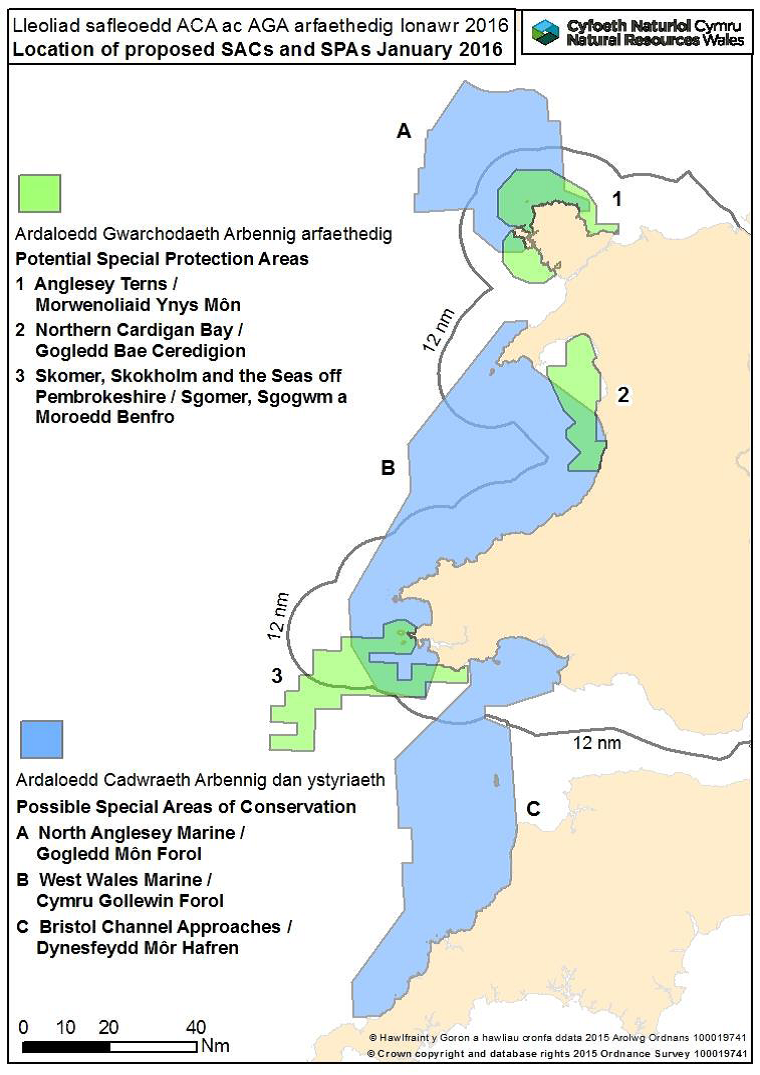Article by Rachel Prior, National Assembly for Wales Research Service
Natural Resources Wales is currently consulting on proposals to create six new marine protected areas in Wales. The proposals include three new Special Areas of Conservation (SACs) and three new extensions to existing Special Protection Areas (SPAs). You can view the full consultation documents on NRW’s website here: Consultation to protect important sea areas The consultation closes on 19 April 2016.
What is being proposed?
The proposed Special Areas of Conservation (SACs) are designed to protect harbour porpoises in Welsh waters. The three SACs proposed are North Anglesey Marine, West Wales Marine, and Bristol Channel Approaches, covering a total area of over 16,000km2. The Bristol Channel Approaches SAC is under the joint control of NRW, Natural England and Joint Nature Conservation Committee. You can read about the consultation here: Bristol Channel Approaches Selection Document. Harbour porpoises are protected species under both UK and EU law. In October 2014 the European Commission warned the UK and devolved administrations about their failure to designate enough sites to protect harbour porpoise in UK waters. This resulted in a UK wide survey of suitable sites and the current proposals for three sites in Welsh waters. The three proposed Special Protection Areas (SPAs) are designed to protect threatened species of seabirds, particularly migratory birds. The first is an extension of an existing SPA at Anglesey to protect breeding tern colonies and their foraging area. The second is in Northern Cardigan Bay to protect the wintering population of red throated diver. The third is an extension to an existing SPA at Skomer and Skokholm for Manx shearwater and Atlantic Puffin. Skomer and Skokholm already protect large populations of Manx shearwater, less black backed gull and Atlantic Puffin. The new SPA would include the islands themselves and further large sea areas extending from the Pembrokeshire coast. All six proposed areas are shown on the NRW map below: [caption id="attachment_5639" align="alignnone" width="682"] Map of proposed Special Protection Areas and Special Areas of Conservation in Wales (Image from Natural Resources Wales).[/caption] If protected, these new areas will add to the Natura 2000 network, which protects breeding and resting sites for rare and threatened species, as well as rare habitat types within Europe, already covering six per cent of the EU’s marine territory and 18 per cent of its land area in over 27,000 designated sites. According to NRW, Wales already has 20 marine sites in this network within 0-12 nautical miles of the Welsh coast, covering nearly 40 per cent of Welsh territorial seas, as well as many land sites.
Map of proposed Special Protection Areas and Special Areas of Conservation in Wales (Image from Natural Resources Wales).[/caption] If protected, these new areas will add to the Natura 2000 network, which protects breeding and resting sites for rare and threatened species, as well as rare habitat types within Europe, already covering six per cent of the EU’s marine territory and 18 per cent of its land area in over 27,000 designated sites. According to NRW, Wales already has 20 marine sites in this network within 0-12 nautical miles of the Welsh coast, covering nearly 40 per cent of Welsh territorial seas, as well as many land sites.
What happens next?
Should Welsh Ministers decide to proceed with designating some or all of these areas, the formal designation process is slightly different for SACs and SPAs. For SACs, Welsh Ministers must submit candidate SACs to the European Commission. If they are accepted by the Commission as a ‘Site of Community Importance (SCI)’, Welsh Ministers then have up to six years to formally designate the sites as SACs and implement all necessary management measures. For SPAs, the decision rests with Welsh Ministers, and the Commission is informed of the creation of the SPA after it is formally classified. Given that the consultation is due to close in April 2016, and assuming few or no amendments to the proposals, the SPAs could be formally classified by summer 2016, with candidate SACs submitted to the Commission around the same time. Approval of the candidate SACs could be delayed if the Commission requires modifications to the proposals before it is prepared to declare the candidate SACs as Sites of Community Importance.






